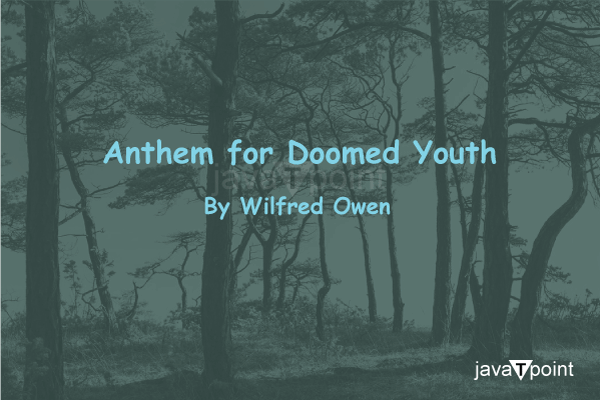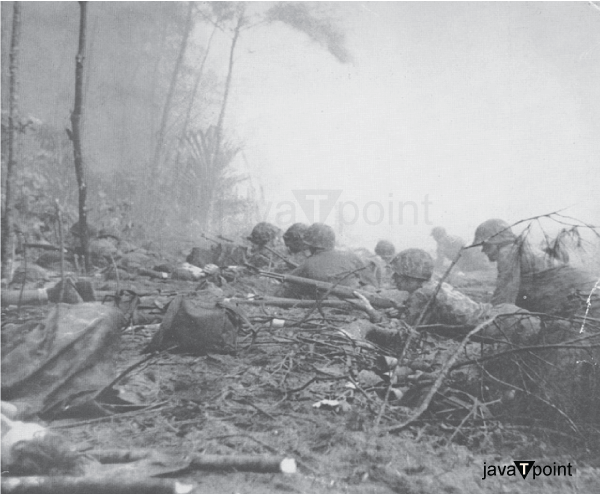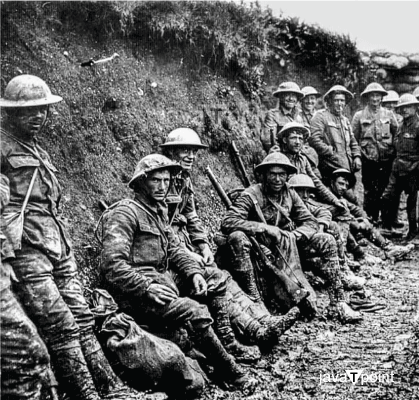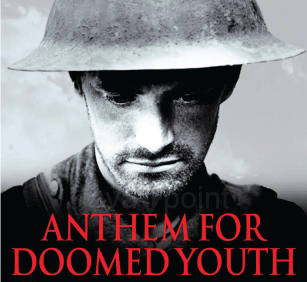Anthem for Doomed Youth SummaryOne of the most well-known English poets of World War I, Wilfred Owen, wrote the stirring war poem "Anthem for Doomed Youth." Owen participated in the war as a soldier, and his personal experiences significantly impacted his poetry. The poem, published after Owen's death in 1917, expresses his disenchantment with war and offers a moving assessment of the terrible toll it takes on the lives of young soldiers. 
In "Anthem for Doomed Youth," Owen examines the concepts of loss, sacrifice, and the inhumane aspect of war. He criticizes the customary rituals and mourning customs connected to war while painting a grim picture of the tragedies experienced by troops using vivid images and powerful language. The poem's structure and use of sound effects enhance its impact and give it a somber, contemplative feel. As we go into this poem's analysis, we'll look at its topics, form, structure, potent language, and imagery and discover the underlying message Wilfred Owen was trying to get over in "Anthem for Doomed Youth." Imagery and LanguageThe melancholy essence of war is skilfully depicted by Wilfred Owen in "Anthem for Doomed Youth" through vivid images and strong words. He paints moving and unsettling pictures with carefully chosen words that have a lasting impression on the reader. Here are some notable instances of the poem's imagery and language: 1. "What Passing-bells for these Who Die as Cattle?" Owen draws attention to the dehumanizing nature of war by using the image of fallen soldiers being compared to animals. It conveys a sense of hopelessness and reduces the soldiers to inanimate objects devoid of personality and humanity. 2. "Only the Stuttering Rifles Rapid Rattle" The gunshot on the battlefield is audibly pictured in this line. The repeating "r" sound and use of alliteration accentuate the chaotic and unrelenting nature of the battle, perfectly encapsulating the terrible aural environment that soldiers are subjected to. 3. "The Shrill, Demented Choirs of Wailing Shells" The personification of shells as "choirs" and the characterization of their noise as "shrill" and "demented" heighten the din of battle. This visual heighten the unrest and fear by depicting the shells as weapons of destruction. 4. "And Bugles Calling for Them from Sad Shires" This passage contrasts the sombre atmosphere of the "sad shires" with the sounds of bugles, typically linked with military rituals and honour. It implies that in light of the brutal realities of war, weeping for the deceased troops in their hometowns is pointless. 5. "Pallor of Girls Brows Shall be Their Pall" Pallor and pall are used as a play on words in this sentence by Owen. The girls' pale foreheads serve as the soldiers' symbolic pallbearers, blurring the distinction between conventional mourning customs and the brutality of battle. 6. "And Each Slow Dusk a Drawing-Down of Blinds" This reminds of a funeral scene where the blinds are drawn to say sorrowfully goodbye to the warriors who have died. "Slow dusk" evokes a sense of melancholy and the passing of time. The reader is submerged in the awful realities of war because of Owen's deft use of vivid and evocative imagery and careful language selection. This technique elicits sorrow, despair, and serious consideration of the human cost of war. The Theme of War and Its Devastating EffectsWilfred Owen's "Anthem for Doomed Youth" theme is war and its terrible results. The poem examines the tremendous and catastrophic effects of war on young soldiers' lives and the lives of society at large. Drawing on his experiences as a World War I soldier, Owen depicts war as a pointless, dehumanizing force that causes unimaginable pain. The following are significant components of the poem's theme: 1. Loss of Youth Owen emphasizes the premature loss of youth brought on by war. Anthem for Doomed Youth's title alone implies that the young warriors are destined to perish in the horrors of war, stripped of their hopes, dreams, and youthful innocence. 
2. Dehumanization Owen underlines how the soldiers are rendered less human by combat. Through powerful language and images, he depicts them as mere animals, highlighting the industrialized and automated nature of combat in which human lives are considered expendable. 3. Absence of Traditional Grieving Rituals The poem raises the issue of whether customary grieving practices for troops who lose their lives in battle are still necessary or even effective. The soldiers are confronted with the constant sounds of gunfire and artillery, depriving them of the respect and dignity they merited in death rather than customary burial procedures and grieving customs. 4. Trauma and Suffering Owen examines war's emotional and physical toll on its warriors. He captures combat's chaotic and unrelenting character through evocative depictions of gunfire, howling shells, and the constant feeling of danger. 
5. War Criticism The poem strongly condemns the pointlessness and savagery of war. Owen undermines the romanticized ideas of war that were common at the time by highlighting the brutal realities and the terrible toll it exacts on both individuals and society. Owen forces the reader to consider the horrors and pointlessness of war by focusing on the issue of war and its catastrophic effects. He aims to evoke empathy, elicit thought, and promote peace and compassion in the face of human suffering through his moving and evocative words. Form and Organization of the PoemThe poem "Anthem for Doomed Youth's structure and form are extremely important to maximizing its overall impact and properly communicating its topics. A sonnet format, specifically a modified Petrarchan sonnet made up of an octet (eight lines) and a sestet (six lines), is used by Wilfred Owen. Let's examine the form and structure in greater detail: 1. Octet (First Eight Lines) The octet poses a challenge or query associated with the poem's central idea. The octet addresses the lack of customary funeral rites for soldiers who die in battle in "Anthem for Doomed Youth," juxtaposing it with the sounds and sights of battle. 2. Sestet (Last Six Lines) The sestet offers a solution or answers to the issue raised in the octet. In "Anthem for Doomed Youth," the sestet considers the constrained and insufficient ways the deceased soldiers are mourned, stressing the terrible nature of their deaths and the long-lasting effects on society. 3.Rhyme Structure The poem uses a deliberate rhyme pattern. The sestet frequently changes, although the octet normally follows an ABAB CDCD pattern. For instance, the rhyme pattern of "Anthem for Doomed Youth" is ABAB CDCD for the octet and EFGEFG for the sestet. 4. Iambic Pentameter Most of the poem is composed in iambic pentameter, with five pairs of stressed and unstressed syllables in each line. This predictable metrical pattern makes the poem's lines rhythmic and musical. 5. Caesura A caesura, a pause or break draws attention to certain words or phrases in poetry. The caesura increases the effect of certain words by giving them a moment of pause, introspection, and emotional weight. Overall, "Anthem for Doomed Youth's shape and structure support its poetic effectiveness. The sonnet form's concision enables a brief and concentrated examination of the poem's themes. The lines have a musical feel due to the tight rhyme scheme and meter, and critical moments are made more emotionally and rhetorically impactful by the clever use of caesura. Stanza 1 Analysis In the first verse of "Anthem for Doomed Youth," Wilfred Owen delivers a strong and striking image that establishes the tone for the entire poem. Let's dissect the stanza more closely: "What passing-bells for these who die as cattle? Only the monstrous anger of the guns. Only the stuttering rifles' rapid rattle Can patter out their hasty orisons." This verse effectively captures the sadness and dehumanization of war. The analysis is broken out as follows: 1. "What Passing-bells for These who Die as Cattle?" The poem's first line poses a rhetorical inquiry highlighting the lack of customary funeral rites for combat fatalities. The comparison of the deceased soldiers to cattle dehumanizes them and implies that they are used as sacrificed animals or just commodities. The term "passing bells" describes the ringing of bells typically used to notify a death and arouse grief. 2."Only the Monstrous Anger of the Guns." This line portrays the guns as manifestations of rage and wrath, emphasizing war's destructive and brutal character. The adjective "monstrous" indicates how powerful and horrible the weapons are. 3. "Only the Stuttering Rifles Rapid Rattle" Owen depicts the sounds of shooting on the battlefield using strong auditory imagery. The idea behind the word "stuttering" is a lack of coherence or control, which reflects how chaotic and frantic fighting is. The idiom "rapid rattle" highlights the rapidity and severity of the firing. 4. "Can Patter Out their Hasty Orisons." Here, Owen compares the idea of solemn prayers (also known as "orisons") and the actuality of battle. Because the prayers of the troops are described as "hasty," it is possible that they will die before they can say the right prayers. The word "patter" conveys a hasty and disorganized way of prayer, underscoring the terrible and sudden nature of their passing. Owen criticizes the soldier's dehumanization and loss of dignity in this poem, challenging the romanticized view of combat. The analogy to animals heightens a sense of sorrow and injustice, the depiction of guns as monsters, and the disjointed prayers. Owen sets the melancholy and critical tone that permeates the poem using rich images and potent words. Stanza 2 Analysis Let's look at the second stanza closely to provide an analysis of it: "What candles may be held to speed them all? Not in the hands of boys but in their eyes Shall shine the holy glimmers of goodbyes. The pallor of girls' brows shall be their pall; Their flowers the tenderness of patient minds, And each slow dusk a drawing-down of blinds." 1. "What Candles May be Held to Speed Them All?" "Speed them all" expresses the wish to send the men to go with due ceremonies and respect. The stanza begins with a rhetorical question, highlighting the lack of traditional candles held to accompany and honour the deceased warriors on their final trip. 2. "Not in the Hands of Boys but in their Eyes shall Shine the Holy Glimmers of Goodbyes" Owen contrasts the guy's lack of candles with the sadness in their eyes as they wave goodbye. The troops farewells are called "holy glimmers," highlighting how meaningful and sacred they were. 3. "The Pallor of Girls Brows shall be their Pall" Here, Owen indicates that the soldier's uniforms will act as a coffin for the girls, represented by their pale foreheads. This sentence highlights the emotional loss loved ones feel and generates a sense of sadness. 4. "Their Flowers the Tenderness of Patient Minds" Owen shifts the attention to the inner feelings and ideas of abandoned people. The sentence implies that the mourners' kind and sympathetic thoughts will act as symbolic flowers to remember the dead warriors. 
5. "And Each Slow Dusk a Drawing-Down of Blinds" "Slow dusk" emphasizes the never-ending cycle of loss and suffering by evoking a sense of melancholy and time passing. In this stanza, Owen explores how the soldiers are remembered and honored while criticizing the absence of customary mourning rites. He draws attention to the poignant goodbyes seen in the eyes of the troops, the girls' pallid expressions of sadness, the heartfelt thoughts of loved ones, and the solemn process of drawing the blinds. Owen effectively expresses the profound sense of loss, grief, and the need for recollection amid war's destruction through these passages. Message and Tone of "Anthem for Doomed Youth" Wilfred Owen's "Anthem for Doomed Youth" exposes the awful reality of war with a potent message and sombre tone. Let's examine the poem's message and tone: 1. Message The poem's main point is to criticize war and its terrible repercussions. Owen brings to light the dehumanization, senselessness, and human suffering brought on by war. He presents a stark contrast between the terrible realities of the battlefield and the lack of appropriate grief and memory for the deceased troops, challenging the romanticized conceptions of heroism and glory frequently connected with fighting. The poem urges compassion, comprehension, and an end to the bloody cycle of conflict. 2. Tone "Anthem for Doomed Youth" is primarily depressing, reflective, and critical. Owen's tone captures the anguish and hopelessness of individuals impacted by war. The poem highlights the loss of young lives and the extreme agony experienced by soldiers, evoking a strong sense of melancholy. Owen criticizes the lack of respect and dignity shown to those who die in battle, and there is an undercurrent of rage and fury. The poem's tone helps convey the subject matter's seriousness to the reader and elicit a strong emotional response from them. The overall message of "Anthem for Doomed Youth" is one of anti-war emotion and serves as a sobering reminder of the toll that war has on its victims. The poem's power is heightened by Owen's solemn and critical tone, which encourages the reader to consider the terrible effects of war and work toward a more compassionate and peaceful society. |
 For Videos Join Our Youtube Channel: Join Now
For Videos Join Our Youtube Channel: Join Now
Feedback
- Send your Feedback to [email protected]
Help Others, Please Share









